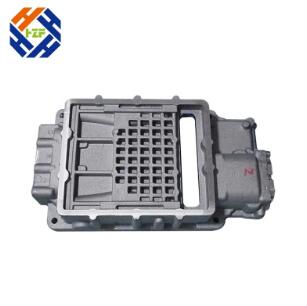The Manufacturing Process of Aluminum Casting Engine Covers
2024-09-02
Aluminum casting is a complex yet fascinating process that transforms raw aluminum into precise and durable engine covers. The process involves multiple steps, each critical to ensuring the final product meets the stringent quality and performance standards required in the automotive industry. This blog will take you through the detailed manufacturing process of aluminum casting engine covers, highlighting the techniques, challenges, and innovations that make it possible.
Step 1: Designing the Mold
1. CAD Modeling
- Computer-Aided Design (CAD): The process begins with the creation of a detailed CAD model of the engine cover. This digital blueprint includes all the specifications, dimensions, and design features required for the final product. The CAD model is essential for ensuring precision and accuracy in the casting process.
- Simulation and Testing: Before the actual casting, simulations are run to test the design under various conditions. This helps identify potential issues such as weak spots or areas prone to defects, allowing engineers to make necessary adjustments to the mold design.
2. Mold Fabrication
- Material Selection: The mold used for casting the engine cover is typically made from steel or iron, materials that can withstand the high temperatures and pressures involved in the casting process. The choice of mold material is critical for achieving the desired surface finish and dimensional accuracy.
- Core Formation: In cases where the engine cover design includes hollow sections, cores are used to create these spaces within the mold. Cores are typically made from sand or other materials that can be easily removed after casting.
Step 2: Melting and Pouring the Aluminum
1. Aluminum Melting
- Furnace Heating: The aluminum alloy is melted in a high-temperature furnace until it reaches the desired liquid state. The specific alloy composition is chosen based on the required properties of the engine cover, such as strength, ductility, and thermal conductivity.
- Degassing and Fluxing: To improve the quality of the molten aluminum, degassing and fluxing processes are performed. Degassing removes dissolved gases that could cause porosity in the final product, while fluxing helps in removing impurities from the molten metal.
2. Pouring the Molten Aluminum
- Gravity Casting: In this method, molten aluminum is poured into the mold using gravity. The simplicity of gravity casting makes it suitable for producing engine covers with straightforward designs and minimal internal cavities.
- Die Casting: For more complex designs, die casting is used. This process involves forcing the molten aluminum into the mold under high pressure, ensuring that the metal fills all the intricate details of the mold. Die casting is ideal for engine covers that require a high level of precision and a smooth surface finish.
Step 3: Cooling and Solidification
1. Controlled Cooling
- Cooling Rates: The rate at which the aluminum cools and solidifies is carefully controlled to prevent defects such as warping or cracking. Cooling too quickly can lead to residual stresses, while cooling too slowly can cause the metal to become too brittle.
- Solidification Patterns: The solidification process starts from the outer surfaces of the mold and progresses inward. Understanding the solidification patterns helps in designing molds that minimize the formation of defects and ensure uniform material properties throughout the engine cover.
2. Mold Removal
- Demolding: Once the aluminum has solidified, the mold is removed. This step can involve breaking apart a sand mold or opening a metal die. Care is taken during demolding to avoid damaging the newly cast engine cover.
- Core Removal: If cores were used to create hollow sections, they are removed at this stage. Depending on the material used for the cores, this can involve breaking them apart or washing them out.
Step 4: Finishing and Quality Control
1. Surface Finishing
- Trimming and Grinding: Excess material, such as flash or sprues, is trimmed away from the engine cover. Grinding is performed to smooth out rough edges and achieve the desired surface finish.
- Heat Treatment: Depending on the requirements, the cast engine cover may undergo heat treatment to enhance its mechanical properties. Processes like annealing or tempering can improve strength, ductility, and resistance to thermal fatigue.
2. Quality Inspection
- Non-Destructive Testing (NDT): Techniques such as X-ray inspection, ultrasonic testing, or dye penetrant testing are used to check for internal defects like cracks, voids, or porosity. NDT ensures that the engine cover meets the required quality standards without damaging the part.
- Dimensional Inspection: The final dimensions of the engine cover are measured to ensure they match the original CAD design. Precision is critical for ensuring that the engine cover fits properly and functions as intended.
Innovations in Aluminum Casting for Engine Covers
1. Advanced Alloys
- High-Performance Alloys: The development of advanced aluminum alloys with improved properties, such as higher strength-to-weight ratios and better thermal stability, is driving innovation in engine cover manufacturing. These alloys enable the production of lighter, more efficient engine components.
2. 3D Printed Molds
- Additive Manufacturing: The use of 3D printing to create molds and cores is revolutionizing the casting process. Additive manufacturing allows for the creation of highly complex mold designs that would be difficult or impossible to achieve with traditional methods, enabling more intricate and optimized engine cover designs.
Conclusion
The manufacturing process of aluminum casting for engine covers is a sophisticated and highly controlled operation that combines traditional techniques with modern innovations. From the initial design phase to the final quality checks, each step is crucial in producing engine covers that meet the high standards of the automotive industry. As technology continues to evolve, we can expect even greater advancements in aluminum casting, further enhancing the performance and efficiency of future engine covers.



